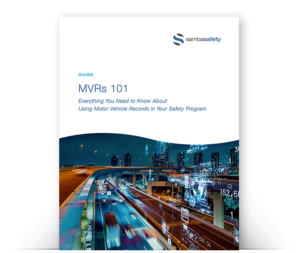Motor vehicle records (MVRs) are a necessary component of proactive fleet management. This is especially so for companies managing commercially licensed drivers. By understanding the CDL MVR, organizations can prioritize safety, mitigate risks and maintain compliance with Federal Motor Carrier Safety Association (FMCSA) regulations governing commercial driver’s licenses – ultimately fostering efficient and responsible fleet management practices. In this blog, we’ve answered some of the most commonly asked questions when it comes to reviewing an MVR for CDL drivers.
Explore Our Free Guide:
MVRs 101
3 FAQs About the CDL MVR
1. What Does a CDL MVR Show?
A CDL MVR provides insight into:
- License Class: The CDL MVR indicates the specific class of the driver’s commercial license, such as Class A, B or C, which determines the type of vehicles they are authorized to operate.
- Endorsements: Any additional endorsements the driver holds, such as hazardous materials (Hazmat), passenger transport, tankers, doubles/triples or other specialized endorsements, are listed in the CDL MVR.
- Restrictions: The MVR indicates any restrictions or limitations imposed on the driver’s license, such as a requirement to wear corrective lenses, a restriction to automatic transmissions only or a time-specific restriction for driving certain types of vehicles.
- Violations and Convictions: This section of the MVR lists any traffic violations or convictions the driver has incurred, such as speeding, reckless driving or DUI/DWI offenses. It provides information on the date of the violation, the location and the type of offense committed.
- Suspensions and Revocations: The CDL MVR records any periods of license suspension or revocation, including the reasons behind them. This can include driving-related infractions, failure to comply with regulations or other violations.
- Crashes: The MVR includes details of any crashes the driver has been involved in while operating a commercial vehicle. This information typically includes the date, location and nature of the crash, as well as any fault or citations associated with it.
- Medical Certification: CDL holders are required to undergo regular medical examinations to ensure they meet the physical qualifications necessary for safe commercial driving. The MVR may contain information on the driver’s medical certification status and expiration dates.
2. Are All MVRs the Same from State to State?
While there are certain similarities in the information provided, there can be variations in the specific details and formatting of MVRs from state to state. The differences can arise due to variations in state laws, regulations and reporting practices.
Each state has its own Department of Motor Vehicles (DMV) or equivalent agency responsible for managing driver records and issuing CDLs. These agencies set their own guidelines for what information is included in an MVR and how it is presented. Therefore, while the core information, such as license class, endorsements, violations and crashes, may be common across states, the way it is displayed or the specific codes used may differ.
It’s important to note that states may also have different rules and regulations regarding the retention of certain information on MVRs. For example, some states may remove certain violations or incidents from a driver’s record after a specific period of time, while others may retain the information indefinitely.
3. How Often Should You Pull an MVR for CDL Drivers?
FMCSA MVR regulations require carriers to pull and review a driver’s MVR before hiring them, with a subsequent mandated pull every 12 months. This is the bare minimum effort required to remain compliant under federal law. However, doing the minimum is a risky way to manage fleet safety. Having large gaps between CDL MVR pulls or relying on self-reporting policies can leave your company vulnerable to liability – as a lot can and will happen in between these reviews.
On the other hand, companies that leverage a continuous MVR monitoring solution can gain access to ongoing CSA and MVR updates, with the ability to take immediate action via proper coaching, training and other necessary interventions. This allows them to intervene before a crash occurs or the driver becomes disqualified. That’s why it’s truly best practice to have round-the-clock visibility into this critical information.
Check out this related blog! Uncovered Exposure: Why Relying on an Annual MVR Review is Risky Business
Stay on Top of Your CDL MVRs
Although you may be satisfied with your fleet’s behavior on the surface, understand that, despite the wealth of information those yearly MVR pulls seem to have, they’re only providing you with a snapshot in time. To learn more about how to better analyze MVRs and ensure all of your drivers meet the necessary standards at all times, download our free guide, “MVRs 101: Everything You Need to Know About Using Motor Vehicle Records in Your Safety Program.”
You may also like:
- The Basics: MVR Records for Employers, Explained
- 6 Tips for Creating a Corporate Driver Safety Program that You Can Feel Confident In


